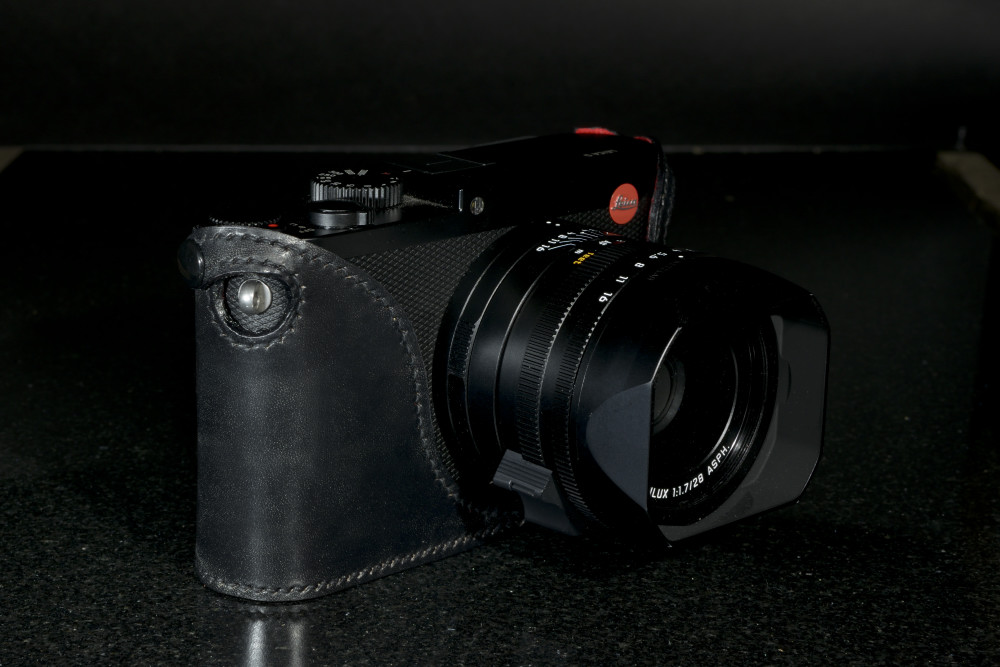
The classic camera half case is as popular as ever. Few people these days want the other bit that covers the front of the camera; that is definitely a dated accessory. But any Leica owner will have cast eyes over a half case or, as Leica like to call them, camera protectors.
It seems, though, that a smart Italian name is a recipe for success, even if some of these Italians do in hail come from the Far East. It’s a change, then, to get my hands on a genuine, British-crafted case for Leica’s new offspring, the Q.

Down in Bovey Tracey, Devon, Paul Glendell is a craftsman who is not only an expert in saddlery, he is also a keen photographer and, indeed, the owner of a new Leica Q. So he had every incentive to design and manufacture the first Q case to come out of Britain. Through his Classic Cases company, Paul specialises in the traditional leather style that graced most cameras through much of the last century. Every case is individually crafted to ensure a perfect fit.
The new Q case is a good example of the genre. It is made from high quality oak-bark tanned English leather and is tailored like a Savile Row suit to fit the Leica very closely. The smooth outer surface is in direct contrast to the embossed leathers we often see on camera cases these days. It just looks right for a Leica, old or new, and I know that many owners prefer this traditional appearance.

Experience tells me that as the leather wears in the case will become softer and will mould perfectly to the body. I was impressed by the precise tailoring of the case to accurately trace the lines of the screen and buttons. Unlike open-back designs, this case attempts to offer greater protection if the camera is dropped. To some extent, the leather frame will prevent damage to the screen. It has the incidental advantage of helping suppress inadvertent button presses—although it has to be said that the Q is one of the least offenders in this respect. Interestingly, the leather surrounding the four-way direction pad is shaved back slightly to enable easier access.

As you see from the pictures, the stitching is neat and the back of the camera looks just right. The example I tried will not accommodate a thumb grip (such as Match Technical’s stunning new Thumbs Up for the Q). However, Paul will be happy to adjust the case if you warn him you expect to use a grip. He can also offer a removable flap to cover the back of the camera.
The Q case comes in black, light brown (natural) or the more classic rich brown familiar to Leica classic owners. There is a choice of three interior colours, red, blue or green. You can even have your initials embossed on the bottom to add a touch of individuality.
In the video on this page you can see the origin of the fine English leather: Paul Glendell’s narrated slideshow on J & FJ Baker’s oak bark tannery in Colyton. This old-established firm follows a tradition started in the same area in Roman times.
In use, the Classic Case feels extremely comfortable, and, while there is no built-in front grip, the leather does offer a better feel than you find with the naked camera.
Paul’s Classic Cases have a loyal following in the Leica world and he supplies several specialist retailers such as Meister Camera, Berlin’s premier Leica outlet in Fasanenstrasse.
The quality and construction certainly impresses and I was surprised at the relatively low price tag. At £145 it is at least £100 less than you would pay for, say, a Korean-made Arte di Mano case. It’s an important difference and one that can only benefit our only (as far as I know) British manufacturer of quality camera cases.
You can find full details of Classic Cases here. Paul also supplies matching wrist and neck straps.
